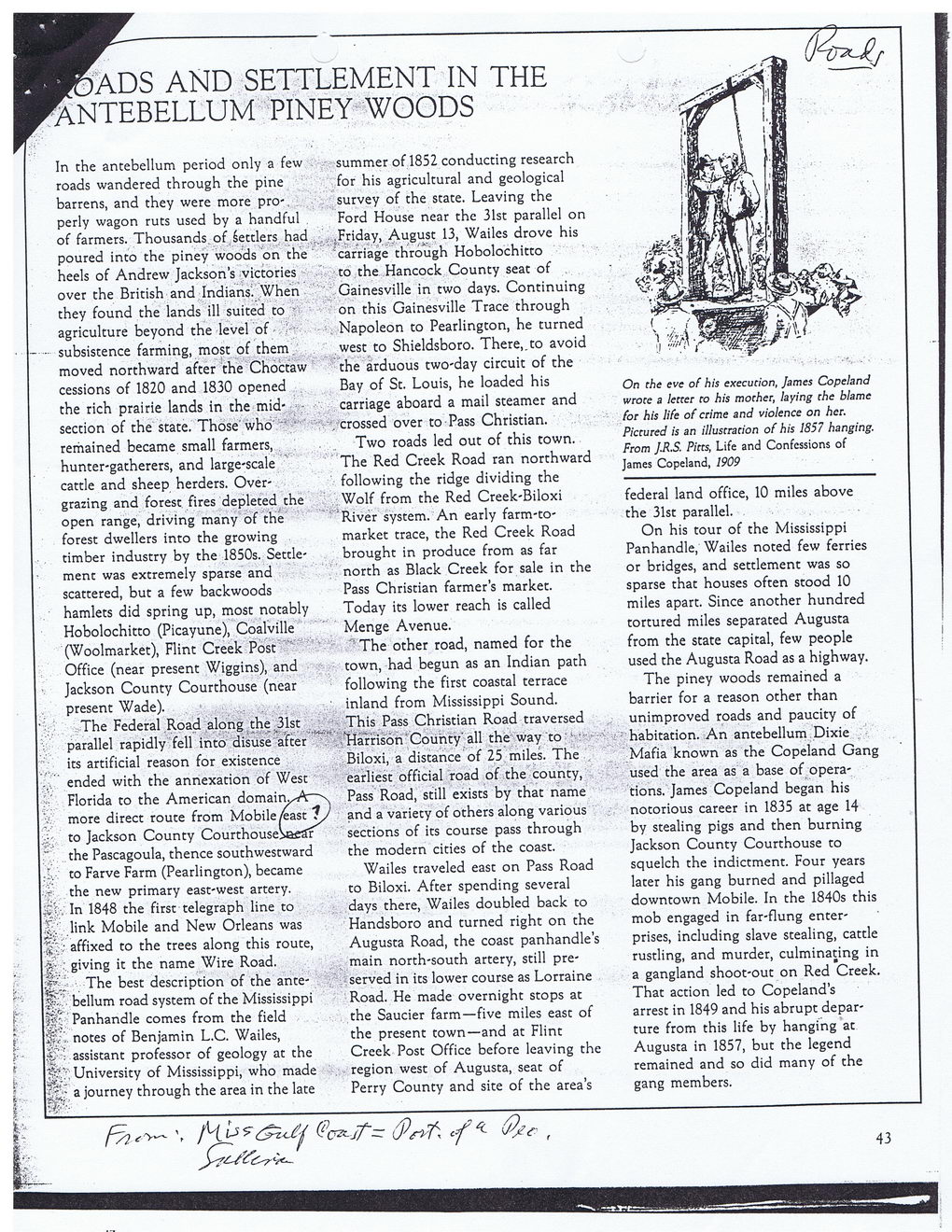This text was obtained via automated optical character recognition.
It has not been edited and may therefore contain several errors.
ADS AND SETTLEMENT IN THE ANTEBELLUM PINEY WOODS
•r-7-fe ■'{t'r .
w
In the antebellum period only a few : roads wandered through the pine barrens, and they were more pro-, perly wagon ruts used by a handful . of farmers. Thousands, of Settlers had^-, poured into the piney woods on the’: heels of Andrew Jackson’s victories over the British and Indians*. When they found the lands ill suited to ?!- ■ agriculture beyond the level of ■ subsistence farming, most of them, moved northward after 'the Choctaw *r cessions of 1820 and 1830 opened the rich prairie lands in the midsection of the state. Those' who ■* remained became small farmers, , , hunter-gatherers, and large-scale cattle and sheep herders. Over-grazing and forest fires depleted the J, open range, driving many of the forest dwellers into the growing timber industry by the 1850s. Settlement was extremely sparse and scattered, but a few backwoods hamlets did spring up, most notably Hobolochitto (Picayune), Coalville (Woolmarket), Flint Creek Post Office (near present Wiggins), and Jackson County Courthouse (near present Wade).
-The Federal Road along the 31st parallel rapidly fell into disuseafter its artificial reason for existence ended with the annexation of West Florida to the American domain.^-" more direct route from Mobile/east ? to Jackson County Courthouse>aeSr the Pascagoula, thence southwestward to Farve Farm (Pearlington), became the new primary east-west artery.
In 1848 the first telegraph line to link Mobile and New Orleans was affixed to the trees along this route, giving it the name Wire Road.
• The best description of the antebellum road system of the Mississippi Panhandle comes from the field notes of Benjamin L.C. Wailes, assistant professor of geology at the University of Mississippi, who made a journey through the area in the late
summer of 1852 conducting research : for his agricultural and geological survey of the state. Leaving the Ford House near the 31st parallel on ^Friday, August 13, Wailes drove his J carriage through Hobolochitto to the Hancock County seat of Gainesville in two days. Continuing on this Gainesville Trace through . Napoleon to Pearlington, he turned west to Shieldsboro. There,.to avoid ■' the arduous two-day circuit of the Bay of St. Louis, he loaded his carriage aboard a mail steamer and ■^crossed over to Pass Christian.
Two roads led out of this town. The Red Creek Road ran northward following the ridge dividing the .. Wolf from the Red Creek-Biloxi ^ River system. An early farm-to-market trace, the Red Creek Road brought in produce from as far ‘ north as Black Creek for sale in the Pass Christian farmer’s market.
Today its lower reach is called Menge Avenue.
: ' The other road, named for the * : town, had begun as an Indian path following the first coastal terrace ■ inland from Mississippi Sound.
;?*. This Pass Christian Road traversed ***'* garrison'County' all the-way to‘-:r/:< Biloxi, a distance of 25 miles. The earliest official road of the^county, Pass Road, still exists by that name and a variety of others along various sections of its course pass through the modern cities of the coast.
Wailes traveled east on Pass Road to Biloxi. After spending several days there, Wailes doubled back to Handsboro and turned right on the Augusta Road, the coast panhandle’s main north-south artery, still pre-■ served in its lower course as Lorraine Road. He made overnight stops at the Saucier farm—five miles east of the present town—and at Flint Creek Post Office before leaving the region west of Augusta, seat of Perry County and site of the area’s
On the eve of his execution, James Copeland wrote a letter to his mother, laying the blame (or his life of crime and violence on her. Pictured is an illustration of his 1857 hanging. From J.R.S. Pitts, Life and Confessions of James Copeland, 1909
federal land office, 10 miles above the 31st parallel.
On his tour of the Mississippi Panhandle, Wailes noted few ferries or bridges, and settlement was so sparse that houses often stood 10 miles apart. Since another hundred tortured miles separated Augusta from the state capital, few people used the Augusta Road as a highway.
The piney woods remained a barrier for a reason other than unimproved roads and paucity of P" habitation. An antebellum Dixie Mafia known as the Copeland Gang used the area as a base of operations. James Copeland began his notorious career in 1835 at age 14 by stealing pigs and then burning Jackson County Courthouse to squelch the indictment. Four years later his gang burned and pillaged downtown Mobile. In the 1840s this mob engaged in far-flung enterprises, including slave stealing, cattle rustling, and murder, culminating in a gangland shoot-out on Red Creek. That action led to Copeland’s arrest in 1849 and his abrupt departure from this life by hanging at Augusta in 1857, but the legend remained and so did many of the gang members.
f?l^\ (fee ,
43

Old Spanish Trail Document (046)